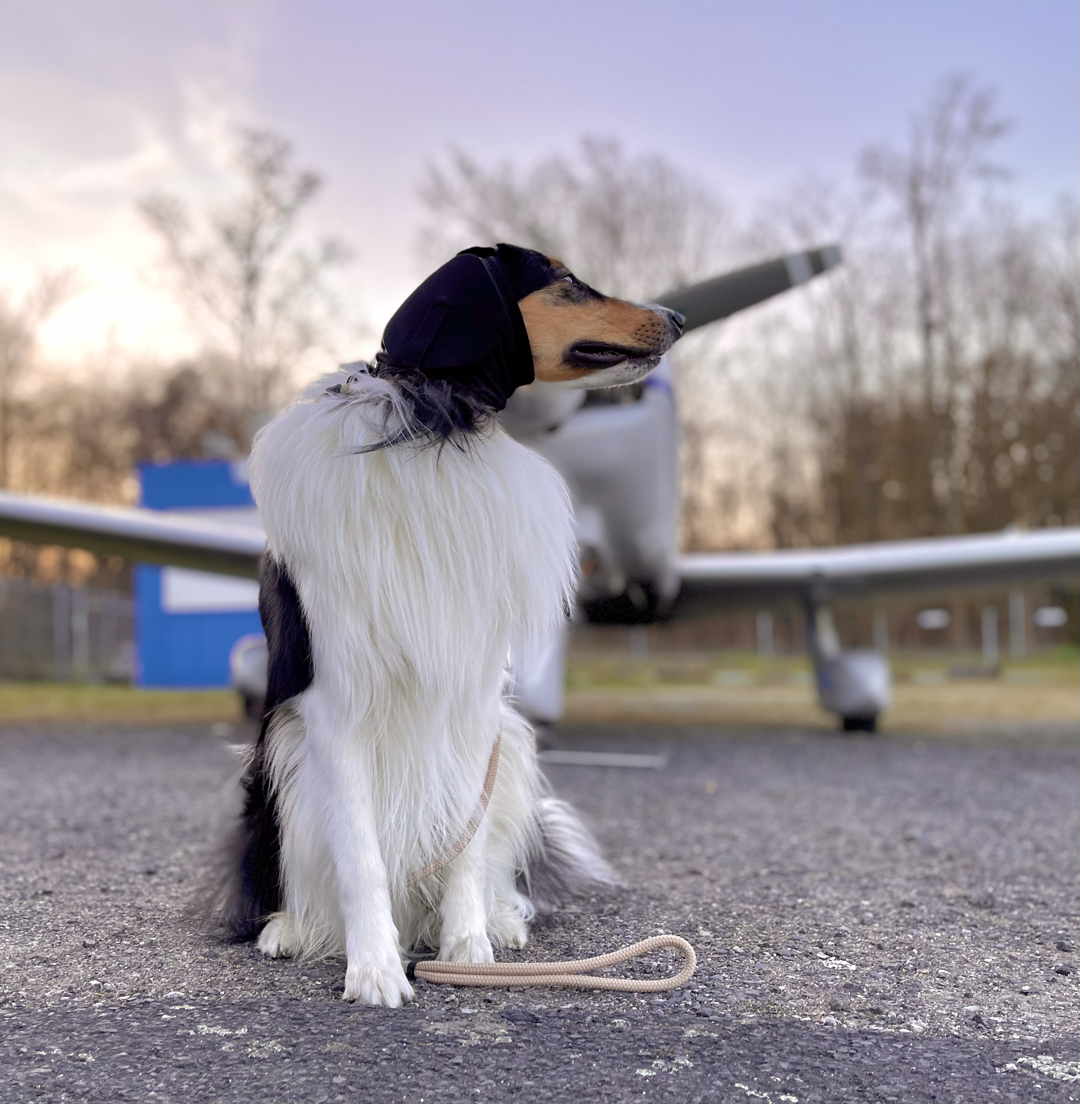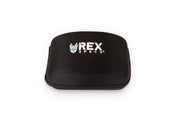Flying with a dog
Experiences and tips from two pilots who take their four-legged friends into the cockpit.
Shortly after we were able to sell the Ear Pro hearing protection from Rex Specs here in Germany, we received an inquiry from Saskia, who regularly flies with her American Collie "Smokey". The topic was very interesting to us and we wanted to find out more from Saskia.
HOW DID YOU GET YOUR DOG USED TO FLYING?
We started taking Smokey to the airfield early on so he could just watch everything, especially the sounds there. He wanted the airfield to be normal for him, like driving in a car or going to the groomer for other dogs. So we often just sat on a bench at the airfield and Smokey chewed on his bone or played a game.

FIRST FLIGHT WITH A QUIET AQUILA A210 AIRCRAFT
It took six months until our first flight. We would have liked to have flown earlier, but information on flying with a dog is rather sparse. How do you get a dog used to flying properly? What safety equipment do dogs need on airplanes? (Buckets, hearing protection, etc.) We didn't have a plane at first, and some people in the flying club were also unsure how it would work and were very skeptical about the safety aspects. So there were a few things that had to be clarified first. Then, all of a sudden, we got the go-ahead: we were allowed to fly. We chose an Aquila A210, a two-seater sports plane with plenty of space in the trunk. The Aquila is the quietest plane in the fleet and was ideal for our first flight. The first steps were to see if Smokey would fit in the plane , if we could buckle him in properly, if necessary, calm him down during flight, and also how to protect ourselves so that he didn't just jump forward. But the most important thing was to see how he behaved in an airplane. The first flight required more courage and ingenuity, since we were leaving for the weekend. So, we closed our eyes and got through it. Armed with chew bones and dog food, which we could feed him if he needed a distraction. But Smokey was calm from the very first second and fell asleep immediately after takeoff.
WHICH PLANE DO YOU TAKE YOUR DOG SMOKEY ON?
Aquila A210 from Aquila Aviation 2 seater
Piper PA28 181 Acher II 4 seater
Piper PA28 161 Cadet 4 Seater
We usually fly the Piper PA28 Archer II. This is the largest aircraft, with plenty of room for Smokey to climb in and out on his own. It serves as a touring plane for us with a sufficient payload (90 kg in the trunk, enough for a 25 kg Collie). Even though the plane is considerably louder, he usually sleeps especially well in it :) since he started wearing the Ear Pro dog hearing protection from Rex Specs.

HOW LONG IS YOUR FLIGHT?
Our flights are max. 2.5 hours at a time, usually 1.5 - 2 hours
WHERE CAN SMOKEY FLY?
Everywhere! From a sightseeing flight to the Frankfurt skyline to a week's holiday in the Bavarian Forest, where we visited a different place every two days. Whenever we fly, he's there.
HOW DO WE CHOOSE OUR FLIGHT DESTINATIONS WITH DOGS?
There should always be something for Smokey, and we choose the destinations accordingly: Is there a lake nearby that we can walk around? Is there a nice hiking trail near the airport? Is there a park or promenade in the city we are visiting that we can walk along? Are there bikes to rent so we can go on a bike tour?
So far we have always found what we were looking for and have gotten to know the beautiful nature around flying.
WHAT IS OUR DOG FLYING EQUIPMENT?
- Dishes
- Hearing protection
- 2 seat belts (hooked to the front and back of the harness)
- High-visibility vest (mandatory at airports)

WHAT MAKES GOOD DOG EQUIPMENT FOR US?
Good quality, durability, easy handling, good protection, comfort for the dog
Many thanks to Saskia, Steffen and Smokey for the information, we hope you continue to enjoy your flights.
Check out Smokey’s latest adventures on Instagram:
https://www.instagram.com/the_flying_collie/
Flying tips for transporting dogs from the USA
In the US, due to the great distances involved, flying in a private jet is almost a daily occurrence. Rex Specs met Florida pilot Allison Leeward and her dogs Griffon and Merlin to hear about their adventures and learn how to fly with your dog. Allison Leeward is a fourth-generation pilot , so she grew up flying—and so did her dogs. Allison adopted her two Australian Cattle Dogs as puppies and began introducing them to flying as soon as she got them.
Merlin, a Blue Heeler, was six months old when Allison adopted her from the Australian Canine Rescue Society in March 2012. Griffon, a Red Heeler, had her first flight at eight weeks old when Allison picked her up from a rural shelter in Calhoun, Georgia. Now Merlin is loyal and ball-obsessed, while Griffon is brave and always trying to get attention. "They're pretty normal for Heelers," says Allison. "They're totally neurotic and crazy in the best way possible.
Allison usually only takes her dogs when they have a specific adventure destination in mind—although sometimes Griffon comes along for a spin. When they do go on an adventure, she makes sure the flights are never longer than two hours so they don't have to spend too much time in the air without a pee break.
Allison typically flies with her dogs in one of three aircraft: her two-seat Cessna 120, her husband's blue DHC2 Beaver seaplane, or her family's six-seat Kodiak
Both dogs get super excited when they go into the hangar because they can run around off-leash and discover new smells. When it's time to fly, they happily jump into the plane because they know they're going somewhere fun—Griffon has even jumped into other people's planes because she thought she could ride along. "They didn't actually start the engine or take off," says Allison. "But [Griffon] was like, 'I'm fine, when are we going to take off?'"
Allison's favorite adventures with the dogs and her husband are when they fly to a lake in a seaplane and camp on the beach. "We just play Frisbee for hours and then cook a delicious meal at the water's edge."
Recently, Allison's crew flew to Asheville, where Griffon saw snow for the first time (and loved it). However, Allison says the return flight was a very smelly one due to the dog farts. Without windows that roll down, dog farting on an airplane isn't a fun experience: "Everyone was throwing up. I don't know what happened, but I think it was all the Christmas treats and cookies."
TOP TIPS FOR FLYING WITH DOGS
Of course, flying with dogs comes with some risks and safety concerns. Allison is aware of this and has developed a process to ensure that her pets are safe and comfortable on every flight. If you're thinking about taking to the skies with your dog, you'll find Allison's best tips here.
USE REX SPECS EAR PRO
On many small private aircraft, the decibel level can be extremely high and can cause noise-induced hearing loss. That's why pilots often wear hearing protection - and your dogs should too!
"My dogs don't feel uncomfortable on an airplane without hearing protection, but I know that in the long run [without hearing protection] they will lose their hearing, and I want to prevent that," says Allison.
PRE-FLIGHT TRAINING WITH DOG
It is extremely important that your dogs have a good recall and listen so that you can keep them safe around airplanes. Allison has put both of her dogs on a professional training program to ensure they have excellent recall and obedience.
When it comes to airplane training, Allison stresses the importance of getting your dog used to the plane and flying before taking any long trips. She recommends taking it slow and adapting the process to your dog's overall confidence in a car or trying new things.
Take the quietest plane you can find and start taxiing around . Then move on to short flights and increase the length of the flight over time. Use plenty of positive reinforcement with treats and attention throughout the process, and have someone sit in the back with your dog to watch for any stress.
In aircraft such as Allison's Cessna 120, where dogs sit in the front seat or have the ability to reach the front seat, consider tethering your dog away from the controls so he cannot interfere.
PRE-FLIGHT EXERCISE
Before the flight, Allison lets her dogs run around and play for a while so they can burn off some of their energy. Once in the air, the dogs lie down for a quick nap before the next adventure begins.





